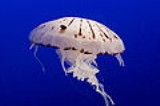
Chrysaora colorata
Encyclopedia
The purple-striped jelly (Chrysaora colorata, formerly Pelagia colorata) is a species of jellyfish
that exists primarily off the coast of California
in Monterey Bay
. The bell (body) of the jellyfish is up to 70 cm (27.6 inches or 2.3 feet) in diameter, typically with a radial pattern of stripes. The tentacles vary with the age of the individual, consisting typically of eight marginal long dark arms, and four central frilly oral arms. It is closely studied by scientists due to not much being known about their eating habits.
Often cancer crabs make home in the jellyfish and eat the parasitic amphipods that feed on and damage the jelly.
The sting of this jellyfish is extremely painful to humans but is rarely if ever fatal.
s, larval fish, ctenophore
s, salp
s, other jellies, and fish eggs.
Jellyfish
Jellyfish are free-swimming members of the phylum Cnidaria. Medusa is another word for jellyfish, and refers to any free-swimming jellyfish stages in the phylum Cnidaria...
that exists primarily off the coast of California
California
California is a state located on the West Coast of the United States. It is by far the most populous U.S. state, and the third-largest by land area...
in Monterey Bay
Monterey Bay
Monterey Bay is a bay of the Pacific Ocean, along the central coast of California. The bay is south of San Francisco and San Jose, between the cities of Santa Cruz and Monterey....
. The bell (body) of the jellyfish is up to 70 cm (27.6 inches or 2.3 feet) in diameter, typically with a radial pattern of stripes. The tentacles vary with the age of the individual, consisting typically of eight marginal long dark arms, and four central frilly oral arms. It is closely studied by scientists due to not much being known about their eating habits.
Often cancer crabs make home in the jellyfish and eat the parasitic amphipods that feed on and damage the jelly.
Description
The Purple Striped Jellyfish is also known as Chrysaora Colorata and the Mauve Stinger. When it is extremely young, it has a pinkish color and its tentacles are long and dark maroon. At the adult stage the dark maroon color of the tentacles starts to fade and the purple appears as stripes on the bell. At a young age the adults' four frilly oral arms will become longer. When the jellyfish starts to get older the tentacles thicken and the purple stripes start to darken and the tentacles start to look pale, its oral arms like to disappear. They are known to feed on a variety of organisms including Cladocera, Appendicularia, Copepoda, Hydromedusae, Siphonophpra, and fish eggs. When the prey touches a marginal tentacle of the jelly, stingers are immediately discharged to paralyze prey and marginal tentacle bends inward to the nearest oral arm. The oral arm is used to transport prey to the gastrovascular cavity (GVC) and to catch motionless prey.The sting of this jellyfish is extremely painful to humans but is rarely if ever fatal.
Diet
Its diet consists of zooplankton, including copepodCopepod
Copepods are a group of small crustaceans found in the sea and nearly every freshwater habitat. Some species are planktonic , some are benthic , and some continental species may live in limno-terrestrial habitats and other wet terrestrial places, such as swamps, under leaf fall in wet forests,...
s, larval fish, ctenophore
Ctenophore
The Ctenophora are a phylum of animals that live in marine waters worldwide. Their most distinctive feature is the "combs", groups of cilia that they use for swimming, and they are the largest animals that swim by means of cilia – adults of various species range from a few millimeters to in size...
s, salp
Salp
A salp or salpa is a barrel-shaped, planktonic tunicate. It moves by contracting, thus pumping water through its gelatinous body...
s, other jellies, and fish eggs.

